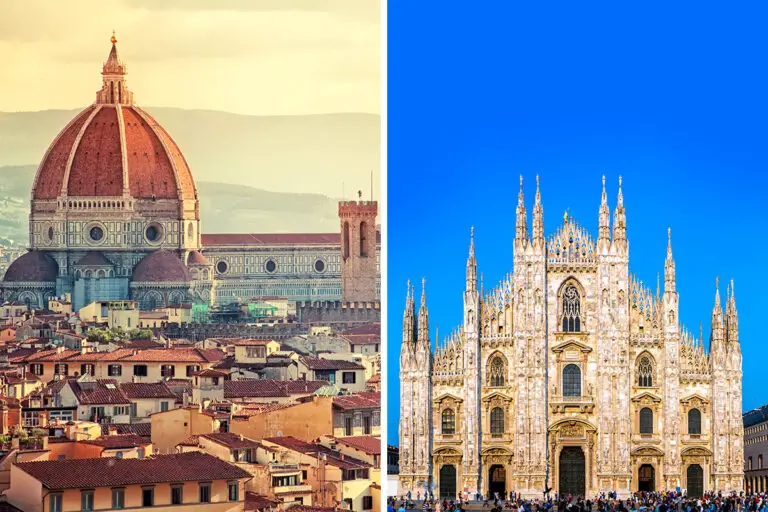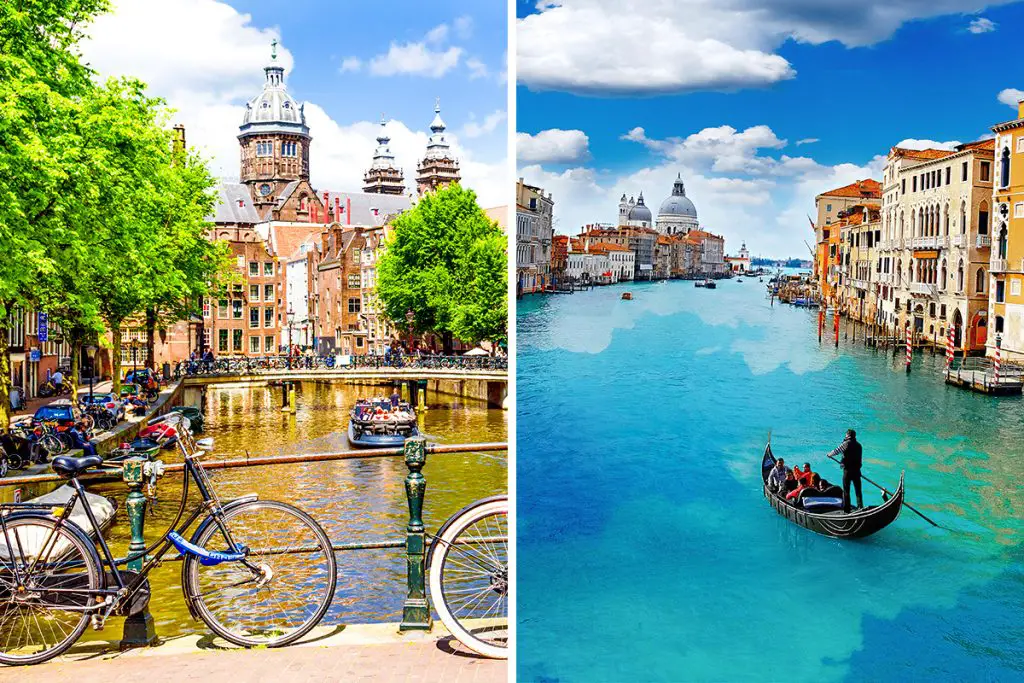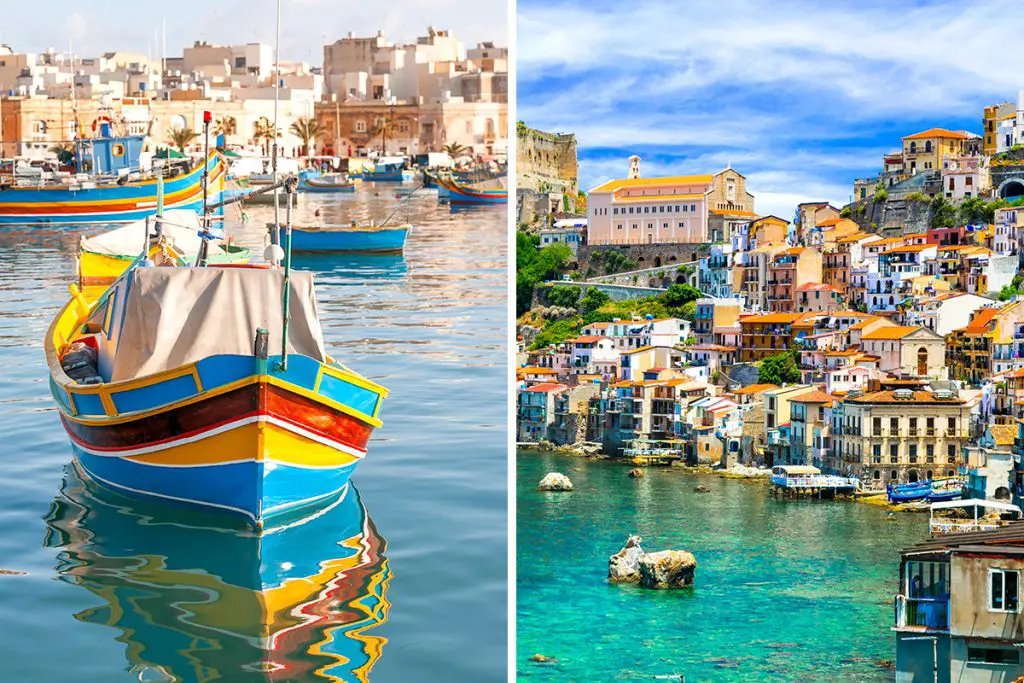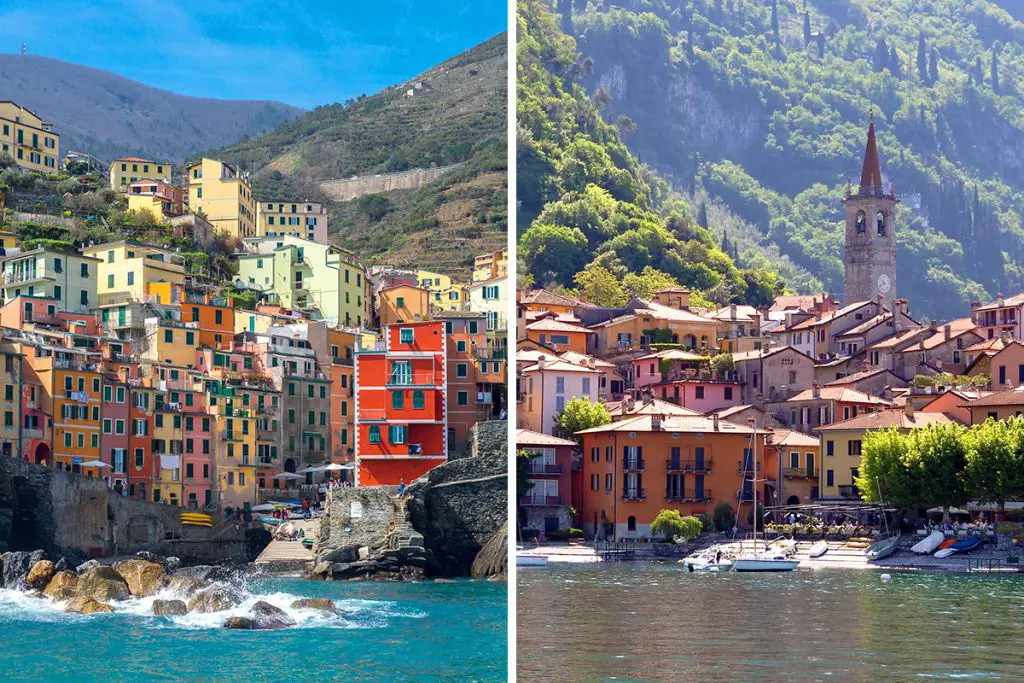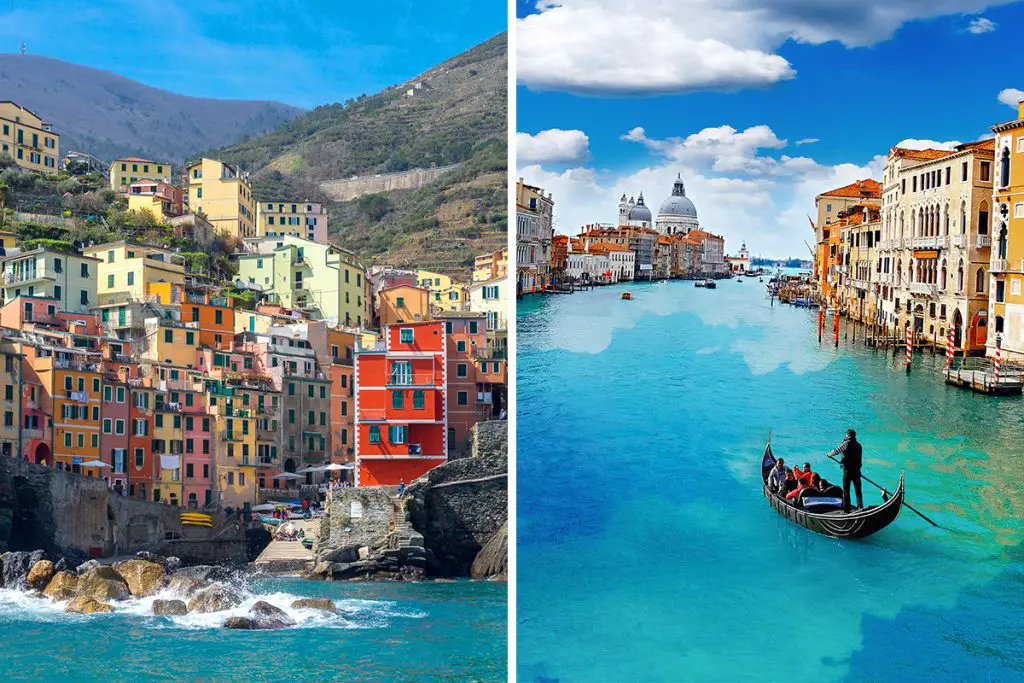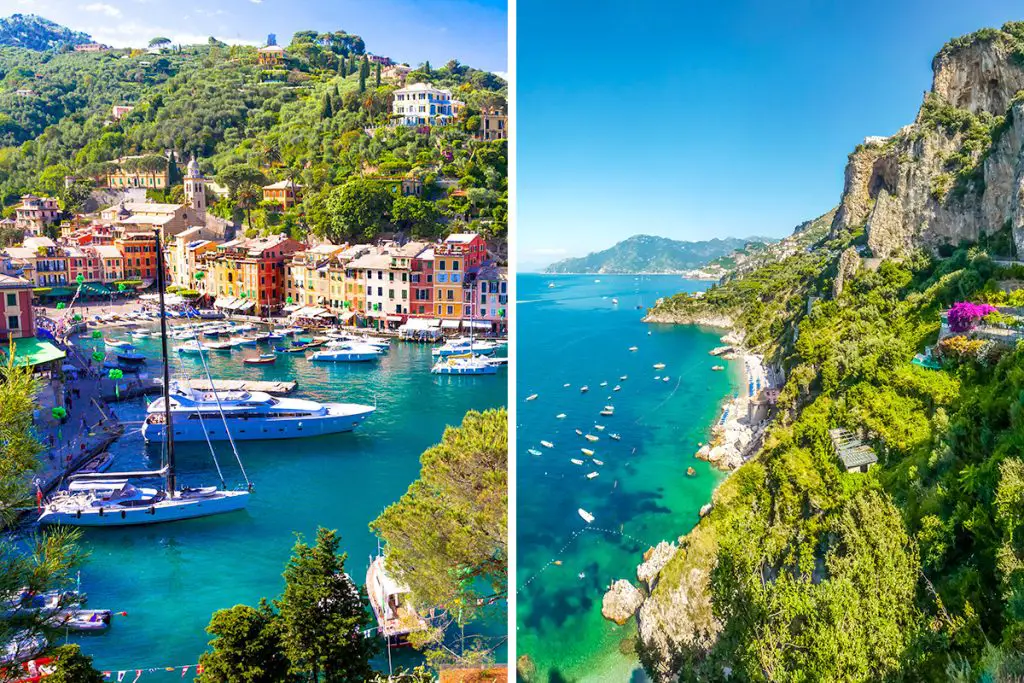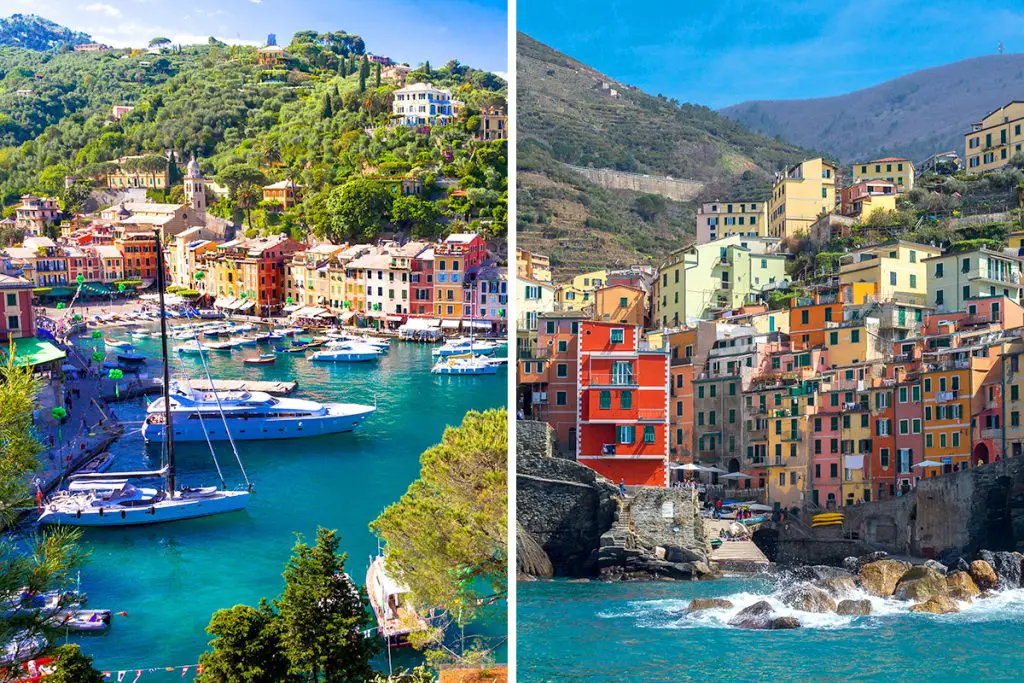Both Florence and Milan are some of the best cities in Italy, making either a great destination. But they offer contrasting experiences that appeal to different travelers.
Milan is a big international city, with a dynamic, fast-paced vibe. Meanwhile, Florence is an easygoing city, with a small-town appeal for an idyllic getaway.
Despite these differences, it can be tricky to decide between Florence and Milan. If you’re still undecided, below is a breakdown of the unique offers of each city!
Florence
Cradled amid scenic hills is Florence, the cradle of the Renaissance that whisks tourists away to the past. Art is everywhere in the city, from buildings, and monuments, to timeless art, and street art. And while this is its main draw, the thriving art scene is not the only reason to come to Florence. Its romantic and relaxed charm, quirky cuisine, and tasty wine are only some that this small yet proud city can offer you.
What Makes Florence Unique?
Italy’s Art Capital
Florence has long had a glorious reputation in the art scene, being the birthplace of the Renaissance. But the city’s art scene is still thriving today, as it’s home to a new generation of creative minds. Florence is where Renaissance meets Contemporary, and it’s an art lover’s paradise.
This isn’t the only reason why Florence is Italy’s art capital. More than half of the world’s most important art pieces are in Italy. And about half of these artworks call Florence their home.
Some of the big hitters in Florence’s art scene are Michelangelo, Dante, Boccaccio, and Brunelleschi. And the best place to see some of their masterpieces is the Uffizi Museum.
The Uffizi is a world-renowned gallery and is one of the largest and oldest ones in the world. Being so, it houses several of the world’s most iconic masterpieces.
One of these is Botticelli’s Birth of Venus, Michelangelo’s Doni Tondo, Caravaggio’s Medusa, and much more. But with these famous artworks, it can be easy to overlook the museum’s impressive and wider art collection. There are tons of other great pieces here, some of which are part of the building itself.
Once you’ve had your fix of timeless art, it’s easy to spot the city’s vibrant contemporary art. Florence has a thriving street art scene that decorates the city. This adds to Florence’s whimsical and charming vibe, surprising you at every corner.
One of the city’s famous artists is Clet, whose unique works add a bit of fun to street signs. Some of these are placing fish bones on a turn sign and putting a nose on the San Niccolo tower.
Blub is another one, a mysterious artist who became popular for his “L’Arte sa nuotare” project. This translates to “art can swim”, and his works are famous artworks depicted in blue, white, and black. Some of these include Botticelli’s Venus or Dali’s portrait, with the subjects wearing a diving mask underwater.
Captivating Architectural Wonders
Strolling around Florence’s streets feels like traveling back in time. There are tons of Renaissance-style buildings around every corner. And not only are these a symbol of Florence’s cultural heritage, but it’s also a display of its architectural prowess.
With tons of gorgeous buildings in the city, Florence is a delight for any aesthete that sets foot in the city. And among all the stunning buildings in Florence, it’s the Duomo that you should never fail to visit.
Located in the Piazza del Duomo, the Cathedral of Santa Maria del Fiore is the pride of the city’s skyline. Its facade will greet you with polychrome marble panels with a delightful mix of green, white, and pink. This architectural masterpiece has a wondrous Gothic Revival exterior and is a UNESCO World Heritage Site.
The city’s oldest religious monument, the Baptistery of St. John is just in front of the Duomo. Built in the Florentine Romanesque style, its octagonal design and marbled facade are already a sight to behold. But its defining feature is its three bronze doors, with reliefs each signed by Michelangelo, Pisano, and Ghiberti.
Within the cathedral complex are other architectural eye candy to awe at. This includes Giotto’s Bell Tower, Brunelleschi’s Dome, and the nave.
Exciting Shopping Scene
While Florence is more well-known for its art, it’s also a retail therapy heaven. It’s a city filled with creativity, so it’s no surprise that Florence has a glorious roster of boutiques to spoil you.
The city’s a conveyor belt of international designer brands for the luxurious fashionista.
For some Italian fashion finds, Via Tornabuoni is your spot. You’ll find a long line of designer boutiques here, some of which are Gucci, Prada, Cartier, and Bulgari.
Continuing the hunt for luxury brands, Via Roma and Via dei Calzaiuoli is also home to high-end shops. Around the area is the retail paradise that is Luisa Via Roma, which houses the latest designs of luxury brands.
While Florence dazzles you with big brand names, they are not the heart of the city’s retail scene. It’s the independent boutiques and ateliers that continue to make Florence’s shopping scene so exciting.
These artisan shops are where centuries-old traditions are still in place. You’ll find almost everything you’d want here. Go through some bespoke pieces, handcrafted jewelry, artisan perfume, leather goods, and more. Not to mention, a wider variety of locally-produced wine.
For some antiques and collectibles, head to Via Maggio or Via de’ Fossi. These two have a collection of important antique shops where you may score some valuable artworks. Strolling around both feels like you’re walking through a museum with their art pieces on display.
For leather finds, make your way to San Lorenzo and Piazza del Mercato Nuovo. Both have open-air markets filled with leather jackets, gloves, wallets, belts, and more! You may even see these artisans create their pieces at the Leather School behind Santa Croce.
For gold and silver jewelry, Ponte Vecchio is the place to be. Here, you’ll find handmade pieces in the countless jewelry shops by the bridge. Bring home some necklaces, earrings, rings, bracelets, and more!
Delicious Florentine Cuisine
The whole of Italy is a food paradise, with Neopolitan pizza and Roman pasta being the star of the show. The underrated Florentine cuisine hasn’t reached global fame. But it’s special in that the city’s medieval history and geography play a big role in the dishes.
Because it’s tucked away in the Tuscan countryside hills, Florence showcases the region’s produce and local goods. These are the staples of the cuisine, unique to the city of Florence. And to truly get a taste of Tuscany’s finest foods, you’ll have to grab a plate of the local favorites.
The most famous Florentine dish is Bistecca alla Fiorentina. It’s a thick cut of dry-aged t-bone, weighing anywhere between 2 to 8 pounds (1 to 4 kilograms). It’s flame grilled with a charred exterior and pink on the inside, seasoned with salt, pepper, and lemon, and cooked over roasted chestnuts.
The meat comes from Chianina cows, which are grass-fed and raised in the Tuscany hills. Perfect for those who have a hearty appetite, this dish only gets better when paired with a carafe or red Tuscan wine.
Florence also has its fair share of tasty soup dishes. Ribollita is a bread-based soup with tomatoes, beans, herbs, and other vegetables. Pappa al Pomodoro is a starchy red soup with tomatoes, basil, garlic, and olive oil.
But with countless other dishes, you can spend a week in Florence without eating the same food twice. And if you’re not sure what to get, just ask the locals!
A Small Town at Heart
Florence may be a bustling global city, but it’s more manageable than other Italian cities. Not only because it’s a smaller city that’s easy to navigate by foot, but also due to its small-town feel. Florence has all the convenience of a metropolitan city, yet it never leaves you feeling too overwhelmed by all the hustle and bustle.
The many natural wonders surrounding and within the city add to Florence’s relaxed vibe. They serve as a scenic retreat to escape the crowds or a place to spend a slow day.
Running through the city is the Arno River, where you can enjoy the glistening waters on a picnic. There are also various hangout spots here, with food trucks, deck chairs, and music to complement the scenery. Enjoy the calm waters on a sunset with a cocktail or beer in hand, as locals do.
If you want to surround yourself with greenery, there are tons of green spaces at your disposal in the city.
On the south of the Arno River is the Giardino delle Rose. It’s a gorgeous garden that features over 30 types of roses, and these bloom by the lemon trees and a Japanese garden in the park.
One of the biggest green spaces in the city is Giardino di Boboli, a sprawling land of centuries-old cypress trees. You can also go sightseeing here as the park has some marvelous sights. This includes the Artichoke Fountain, the Museum of Porcelain, and the Buontalenti Grotto.
If you’re looking for a truly secluded escape, visiting the Tuscan countryside is a must. You’re near the rolling hills of Tuscany anyway, so why not take a day trip?
Lucca and Siena are two medieval towns that are easily accessible from Florence. Enjoy the scenery on a bike or a Vespa, wander through gorgeous villas, or help the locals harvest grapes.
Glorious Tuscan Wine
Cradled in the hills of the famous Chianti region, Florence is one of the best spots in Italy to go wine tasting. Some of the world’s favorite wines originate from Tuscany, such as Chianti and Nobile di Montepulciano. But the city’s local wines do not pale in comparison to these either.
The best way to experience Florence’s passionate wine culture is to take a wine-tasting tour. Escape to Chianti to wander through authentic Italian wineries and lush vineyards. You’ll be sipping on a variety of wines on scenic hills, with views of ancient villages and orange groves.
But you don’t have to stray too far from the city’s center to enjoy a good glass of wine. Florence is full of wine bars that are more than enough to indulge your palate.
Chianti Classico at Mercato Centrale is one of these spots, serving over 400 labels of Florentine wine. Enoteca Pitti Gola e Cantina is another, offering hard-to-find wines from around the country.
Milan
Milan is not your typical Italian city. While others have an idyllic vibe, Milan is ever-lively from day to night like most major international cities. Despite this, Milan’s still rooted in its rich Italian culture. From old-world sights to traditional cuisine to cultured nightlife, the city always has something up its sleeve.
What Makes Milan Unique?
Marvelous Architecture
Milan is not an idyllic destination like other Italian cities that only boast collections of the past. Instead, Milan’s cityscape mixes the old with the new. The city arguably has the most diverse array of architectural wonders, and they’re nothing short of spectacular.
You’ll find magnificent historical buildings here, with sky-high monuments and frilly, intricate details. These coexist among futuristic glass and steel structures that give the city a modern feel.
There are a ton of architectural gems in the city. While trendy buildings have popped up here and there, Milan’s historical landmarks are still its crowning glory.
The most iconic building in the city of Milan is the Duomo di Milano. This elegant cathedral is the icon of the city, and in many ways, one of the main considerations to visit Milan.
The Gothic marble facade is meticulously adorned with spires, pinnacles, and sculptures. And there’s much more to see inside, underneath, and above the cathedral. You can explore the cathedral’s crypts, baptistery, and terraces to get an in-depth view of this gem.
Milan has tons of other buildings spanning different centuries.
There’s the Renaissance church of Santa Maria delle Grazie. The floral art nouveau townhouses of Porta Venezia. And the brutalist icon of Torre Velasca, the modern masterpiece that is Bosco Verticale, and more.
Fascinating Art Collection
Rome and Florence may be Italy’s top destinations for art lovers, but Milan is also a cultural powerhouse. Backed up by a plethora of world-class museums, Milan has no shortage of great art. The city is a treasure trove of works by da Vinci, Michelangelo, and Caravaggio, among others.
Some of the world’s most recognizable artworks are only here in Milan. Because of this, a museum tour of the city’s famous museums is a once-in-a-lifetime experience!
Leonardo da Vinci’s world-famous painting of The Last Supper calls Milan its home. It’s one of the most enduring images in art, and you can find it a Chiesa Santa Maria delle Grazie.
You can also find the last artwork of Michelangelo here, the Pieta Rondanini. It’s a sculpture of Mary mourning over the body of Christ, an unfinished yet haunting piece. You can find this creation at the Castello Sforzesco.
At the Pinacoteca di Brera, you’ll find Caravaggio’s Supper at Emmaus. It’s a painting of a biblical scene that displays the artist’s mastery of light along with a dramatic chiaroscuro.
Francesco Hayez’s most famous masterpiece, The Kiss, is also at Pinacoteca di Brera. The subject depicts a soldier and a maiden embracing, a symbol of love for the motherland. With its exceptional color composition and lighting, the painting evokes a sense of serenity in those who marvel at it.
Italy’s Fashion Capital
Milan is not only Italy’s fashion capital, but it’s also one of the fashion meccas in the world. Shopping in the city is a quintessential experience, being home to the top international designer brands. Due to its reputation, Milan is an endless maze of extravagant shopping districts to spoil you.
Quadrilatero d’Oro, the “golden square” is every fashionista’s dream, being a wonderland of luxury brands. This square got its name from the haute-couture-fringed streets that border it. These are the streets of Via Montenapoleone, Via della Spiga, Via Sant’Andrea, and Via Manzoni.
This area is one of the most prestigious shopping sites in the world. It’s home to the most-coveted brands, such as Prada, Dolce and Gabbana, and Fendi.
Continuing Milan’s luxurious shopping scene is the Galleria Vittorio Emanuele II. This is one of the world’s oldest shopping galleries, and it’s an architectural gem in itself. It also houses designer brands, such as the likes of Louis Vuitton, Armani, and Prada.
Not everything is glitzy and glamorous in Milan’s retail scene though. Milan’s shopping scene also offers vintage pieces, independent boutiques, leather goods, and more. And they don’t have to put a dent in your budget, as long as you know where to look!
Corso Buenos Aires is one of the longest shopping streets in Europe. There are many generations-old stores here, with hundreds of affordable Italian brands. Those coexist with the numerous high-street fashion stores on the street, such as H&M!
Delectable Milanese Cuisine
Being Italy’s bustling economic center, there are countless things to do in Milan. But no matter the reason for your visit, eating as much local food as you can find is one of the top things to do here.
North Italy, of which Milian’s a part, has an interesting and diverse food scene. The region has nine different cuisines, and you can get a taste of all these in a single city, Milan.
Don’t stuff yourself too much with amatriciana and pizza, as there are tons of Northern specialties to discover here. Grab a bite of some of the dishes below and you’ll see why Milan is also a foodie’s heaven.
The quintessential dish in Milan is the Risotto alla Milanese. It’s a velvety fusion of beef broth, Parmesan cheese, and bone marrow, among others. Its iconic yellow coloring comes from saffron, one of the most expensive spices in the world!
Minestrone Milanese is a testament to Milan’s love for rice. What makes this unique from other minestrone in the country is that it uses rice instead of pasta. Mixed with vegetables of all types, this soup is a hearty dish to have no matter the season.
Well-Manicured Green Spaces
Being Italy’s economic center, Milan is the country’s most modern and stylish city. While life here is fast-paced, Milan has a ton of beautiful green spaces, over 80 of them, that serve as your urban oasis. There’s always a pocket of greenery nearby within the city if you want to escape the busy crowds in Milan.
If you don’t know where to go for a change of pace, here are the city’s most well-loved parks—
Parco Sempione is just behind the famous Castello Sforzesco, the most famous green space in Milan. This park is the perfect lush playground for some outdoor fun. It features running trails, playgrounds for kids, and pet-friendly spots.
Not only that, you’ll get a view of the architectural wonder that is Arco della Pace. For a more romantic visit, make your way to the Ponte delle Sirenette in the park. It’s a spot filled with statues of mermaids, one of Milan’s most romantic spots.
If you want to have the city beneath your feet, Monte Stella is the place to be. It’s an artificial mountain that overlooks the city, giving you the best vantage point of Milan.
Porta Venezia is another top park in the city, and it’s a pretty park due to its wide paths and geometric flower beds. A flutter of butterflies is a common sight here, flying amid the countless botanical species in the garden. You have a ton of benches and shady spots here, perfect for a slow day.
Vibrant Nightlife
Frenetic, industrial, and ever-vibrant, Milan stands out from the rest as the city that never sleeps. Locals begin unwinding at 6 PM, making plans for the rest of the night over an aperitif. The city’s energetic and flamboyant vibe reflects in its nightlife, and this is something you shouldn’t miss!
More than its liveliness, the night scene in Milan is delightfully varied. The city flaunts every possible nightlife spot you could think of, from bars to pubs to discos. And depending on your preference, there’s a perfect neighborhood for the night owl in you.
Among the nightlife spots in the city, some stand out as the best-loved districts. Navigli and Brera are some of these, and they’re great spots for your introduction to the city’s cultured night scene.
Navigli is the center of Milan’s nightlife, with spots for tourists of all ages. It has a hipster-ish vibe that appeals to youngsters, with bars and pubs lining the canals. Tons of quirky bars, breweries, and discos are here to host your Milanese night out.
An older part of the city, the Brera district is a treat for the artsy crowd as it’s the original artists’ quarter. Bar Brera features terrace seating, the local’s meeting spot of choice. Head out to N’Ombra de Vin for some wine in a historical building, or to the stylish Bulgari Lounge Bar for a luxurious night.
Florence or Milan – Which Is Better?
Two cities with different vibes, one of these Italian cities is better for you depending on your preference.
Milan is a better choice for lively travelers who can keep up with the city’s fast-paced life. Milan is the perfect city for those whose priority is either shopping or nightlife. It’s the best city to see modern Italy, as no other city in the country can top Milan in this regard.
Florence is the better choice for art lovers, history buffs, or those who want a more traditional Italian getaway. Tourists who want a change of pace will find comfort in Florence’s slower pace. And being so close to the Tuscan countryside, there are tons of off-the-beaten-path opportunities here.
Other than those, visit Florence for its historic culture. It’s the cradle of the Renaissance, and it’s richer in cultural heritage than Milan. Milan’s cultural scene focuses less on history and more on modernity.
Both cities have stunning architectural wonders. In Florence, you’ll find old-world buildings, ranging from Renaissance to Gothic to medieval. Milan’s architectural scene is more futuristic, boasting tons of technical innovation in design.
When it comes to things to do, Florence edges out Milan. There are tons to see and do here around every corner. With the countryside being so close, taking a trip to medieval hill towns is easy.
Shopping in the glamorous retail district is the main thing to do in Milan. There are also theaters, museums, and historical sites here. But there’s not a ton of variety compared to Florence.
FAQ
Duomo in Milan vs. Florence
The focal point of both cities’ cityscape is their Duomo. In Milan, it’s the Duomo di Milano, a grand Gothic church. In Florence, it’s the Cathedral of Santa Maria del Fiore, represents the early Renaissance style.
If you’re looking for the wow factor of the facade itself, Duomo di Milano is a more breathtaking sight. Not only due to its size, being one of the largest Catholic cathedrals in the world, but also for its intricate and elaborate design.
Duomo di Milano has thousands of statues and hundreds of gargoyles and sculptures on its exterior. Not to mention, its towering pinnacles give the structure a more opulent vibe. This duomo has hints of Romanticism, Gothic, and Gothic Revival styles built on top of each other.
The Cathedral of Santa Maria del Fiore is also one of the largest ones in the world. It’s a symbol of the city’s Renaissance identity, mixing with the medieval Tuscan Gothic style. This blend of styles embraced the ornate design of the latter.
Florence to Milan
You have four transportation options on your journey from Florence to Milan. You can either take a bus, a plane, or a train.
Taking a direct bus will cover about 154 miles (249 kilometers), with a travel time of 3 hours and 50 minutes. Average ticket prices cost around 12 USD, but you can find tickets as low as 10 USD. Buses leave only once a day from Florence’s Firenze Santa Maria Novella.
A plane ride between the two cities covers roughly the same distance. But this cuts the travel time to around 1 hour and 30 minutes. The trade-off is its high price tag, with tickets ranging from 30 USD to 186 USD.
Trains are the most popular transportation option between the two cities. The average cost is around 25 USD, and they frequently level Florence for Milan. These trains are direct, so you don’t have to switch trains along the journey.
Florence to Milan Malpensa Airport
Taking a train from Florence to Milan Malpensa Airport is a popular transportation option. This journey covers a distance of 179 miles (288 kilometers). The travel time can take around 3 hours and 28 minutes but can be as short as 3 hours and 6 minutes.
Trains frequently travel this route, with 35 trains departing Florence daily. You need to make one change along the way though, as there’s no direct line between the two destinations.
Train ticket prices on this route start at 33 USD. The first train leaves at 2:03 AM, and the last one leaves at 10:12 PM.
Florence to Milan Bergamo Airport
Trains are the best option when traveling from Florence to Milan Bergamo Airport. This covers a distance of 151 miles (244 kilometers). The trip lasts around 3 hours and 54 minutes on average.
About 6 trains travel this route daily, with 2 direct train options for you. The average train ticket price for this journey is around 25 USD. The first train departing from Florence leaves at 2:03 AM and the last one leaves at 10:25 PM.
Milan to Florence by Train
The train travel from Milan to Florence covers a distance of 155 miles (249 kilometers). Around 48 trains travel this route daily, with the first train leaving at 5:50 AM and the last one leaving at 9:50 PM. The average travel time is 2 hours and 31 minutes, but it can be as short as 1 hour and 37 minutes.
Is There a Direct Train From Milan to Florence?
If you’re traveling with Trenitalia or Italo, you can enjoy a direct train ride from Milan to Florence. Both companies offer a comfortable experience, with leather seats and free WiFi during your journey. Upgrading to First Class will get you a gourmet meal and reclining armchairs for added comfort.
Milan Malpensa to Florence by Train
A train ride from Milan Malpensa Airport to Florence covers 179 miles (288 kilometers). The journey takes about 3 hours and 41 minutes on average. But the fastest trains can cut this time down to only 3 hours and 7 minutes.
Trains frequently run this route per day, with an average of 39 trains departing from Milan. Ticket prices can be as low as 24 USD if you book in advance. The first train leaves Milan at around 12:26 AM, while the last one leaves at 8:26 PM.
There are no direct trains on this journey, so you’ll have to make one switch along the way.
Train From Florence to Milan Linate Airport
Milan Linate Airport doesn’t have a dedicated train station within the building. So if you want to travel from Florence to this airport by train, you have to go to Milano Centrale, the closest station.
Milano Centrale is only 4.8 miles (7.8 kilometers) away from the Milan Linate Airport. And from there, you can hop on a bus that goes directly to the Milan Linate Airport.
Train From Florence to Milan Bergamo Airport
Trains from Florence to Milan Bergamo Airport are not as frequent as other routes. There are only around 6 trains that run between the two per day. It’s best to check online so you can plan your trip in advance.
Still, this is a popular travel option among travelers as it only lasts around 3 hours and 54 minutes. And if you book your tickets in advance, you can get a good deal for as low as 25 USD per ticket.
Milan Centrale to Florence
The journey from Milan Central Station to Florence takes around 2 hours and 39 minutes on average. The fastest time on this route, though, is only 1 hour and 49 minutes! This trip covers a distance of around 156 miles (250 kilometers).
There are tons of trains that run this route per day, around 47 of them. And because there are direct trains on this route, you won’t have to change trains along the way.
The first train leaves Milan Central Station for Florence at around 5:00 AM. While the last train leaves at 9:50 PM.
The cheapest ticket price you can get for your trip is around 10 USD if you book in advance!
Milan to Florence Train Price
Train ticket prices from Milan to Florence cost around 29 USD on average and can go lower to around 24 USD. If you book your tickets in advance, you can get a ticket for only around 10 USD!
How Far Is Florence From Milan by High-Speed Train?
The distance from Florence to Milan on a high-speed train is around 190 miles (306 kilometers). While it sounds far, these speedy trains only have a travel time of around 1 hour and 40 minutes.
Milan to Florence Train Time
On average, the train time from Milan to Florence can take around 2 hours and 46 minutes. But if you choose the fastest train, this can only take around 1 hour and 45 minutes.
Bus From Milan Airport to Florence
A bus ride from Milan Malpensa Airport to Florence has a distance of 178 miles (287 kilometers). It’s a long journey, with an average travel time of 5 hours and 50 minutes. The upside is that the average ticket price on this option is only about 18 USD, and can be as low as 14 USD.
Day Trip to Florence From Milan
A day trip from Milan to Florence is an enticing feat since the travel time is only a few hours away by train. With the first train leaving Milan at 5:50 AM, you can arrive in Florence at around 8 AM. This gives you a ton of hours to explore Italy’s art capital to your heart’s content!
Make sure to come back in time though. The last train leaving from Florence to Milan departs at 10:12 PM.
Best Way to Get From Milan to Florence
Trains have been the top choice of tourists traveling between Milan and Florence. This considers its affordability, speed, and comfort.
A train ride from Milan to Florence only costs around 29 USD. While a bus is cheaper than this, at 18 USD, a train is much faster. Trains only take around 2 hours and 46 minutes on average, but a bus ride takes 5 hours and 50 minutes.
A plane ride between the two cities is the fastest, with a travel time of 1 hour and 10 minutes. But it often costs a few hundred dollars, depending on the date and time. A high-speed train can also rival a plane’s travel time, as these trains can cut down the journey to as short as 1 hour and 45 minutes.

